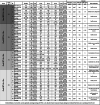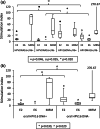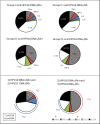Interferon-γ and IL-5 associated cell-mediated immune responses to HPV16 E2 and E6 distinguish between persistent oral HPV16 infections and noninfected mucosa
- PMID: 33421352
- PMCID: PMC8543460
- DOI: 10.1002/cre2.396
Interferon-γ and IL-5 associated cell-mediated immune responses to HPV16 E2 and E6 distinguish between persistent oral HPV16 infections and noninfected mucosa
Abstract
Objectives: Natural history of human papillomavirus (HPV) infection in the head and neck region is poorly understood, and their impact on collective HPV-specific immunity is not known.
Materials and methods: In this study, we have performed a systematic analysis of HPV16-specific cell-mediated immunity (CMI) in 21 women with known oral and genital HPV DNA status and HPV serology (Ab) based on 6-year follow-up data. These women being a subgroup from the Finnish Family HPV Study were recalled for blood sampling to be tested for their CMI-responses to HPV16 E2, E6, and E7 peptides.
Results: The results showed that HPV16 E2-specific lymphocyte proliferation was more prevalent in women who tested HPV16 DNA negative in oral mucosa and were either HPV16 seropositive or negative than in HPV16 DNA+/Ab+ women (p = 0.046 and p = 0.035). In addition, the HPV16 DNA-/Ab- women most often displayed E6-specific proliferation (p = 0.020). Proportional cytokine profiles indicated that oral HPV16-negative women were characterized by prominent IFN-γ and IL-5 secretion not found in women with persisting oral HPV16 (p = 0.014 and p = 0.040, respectively).
Conclusions: Our results indicate that the naturally arising immune response induced by oral HPV infections displays a mixed Th1/Th2/Th17 cytokine profile while women with persisting oral HPV16 might have an impaired HPV16-specific CMI, shifted partly toward a Th2 profile, similarly as seen earlier among patients with high-grade genital HPV lesions. Thus, the lack of HPV 16 E2 and E6 specific T memory cells and Th2 cytokines might also predispose women for persistent oral HPV16 infection which might be related to the risk of cancer.
Keywords: cell-mediated immunity; cytokines; human papillomavirus; oral cavity.
© 2021 The Authors. Clinical and Experimental Dental Research published by John Wiley & Sons Ltd.
Conflict of interest statement
There is no conflict of interest.
Figures





References
-
- Alcocer‐Gonzalez, J. M. , Berumen, J. , Tamez‐Guerra, R. , Bermudez‐Morales, V. , Peralta‐Zaragoza, O. , Hernandez‐Pando, R. , & Madrid‐Marina, V. (2006). In vivo expression of immunosuppressive cytokines in human papillomavirus‐transformed cervical cancer cells. Viral Immunology, 19(3), 481–491. 10.1089/vim.2006.19.481 - DOI - PubMed
-
- de Jong, A. , van der Burg, S. H. , Kwappenberg, K. M. , van der Hulst, J. M. , Franken, K. L. , Geluk, A. , & Offringa, R. (2002). Frequent detection of human papillomavirus 16 E2‐specific T‐helper immunity in healthy subjects. Cancer Research, 62(2), 472–479. - PubMed
-
- de Jong, A. , van Poelgeest, M. I. , van der Hulst, J. M. , Drijfhout, J. W. , Fleuren, G. J. , Melief, C. J. , Kenter, G. , Offringa, R. , & van der Burg, S. H. (2004). Human papillomavirus type 16‐positive cervical cancer is associated with impaired CD4+ T‐cell immunity against early antigens E2 and E6. Cancer Research, 64(15), 5449–5455. 10.1158/0008-5472.CAN-04-0831 - DOI - PubMed
Publication types
MeSH terms
Substances
Grants and funding
LinkOut - more resources
Full Text Sources
Other Literature Sources

